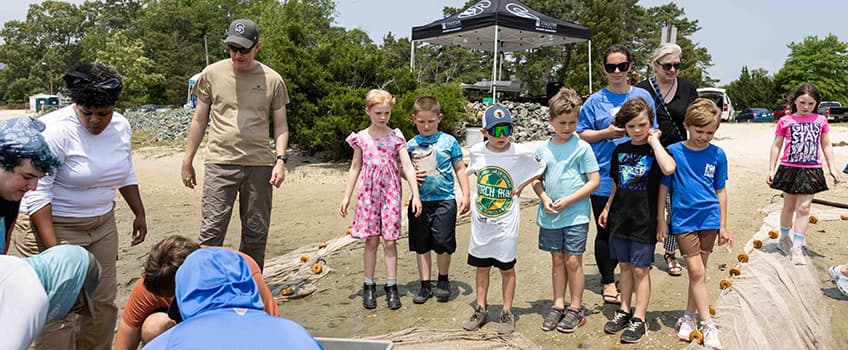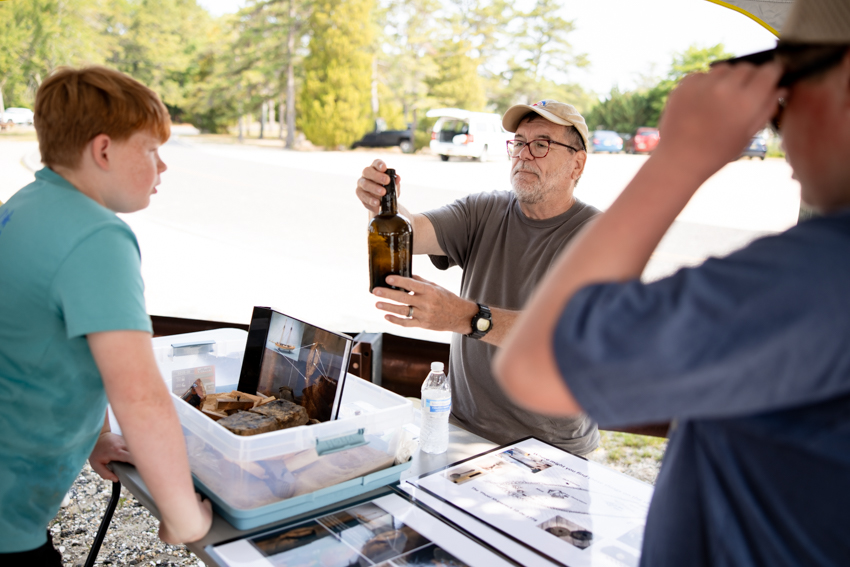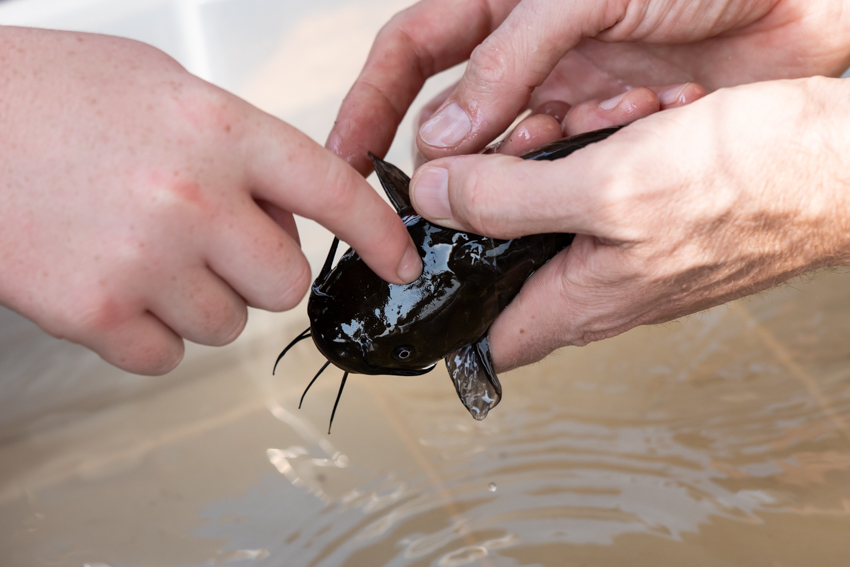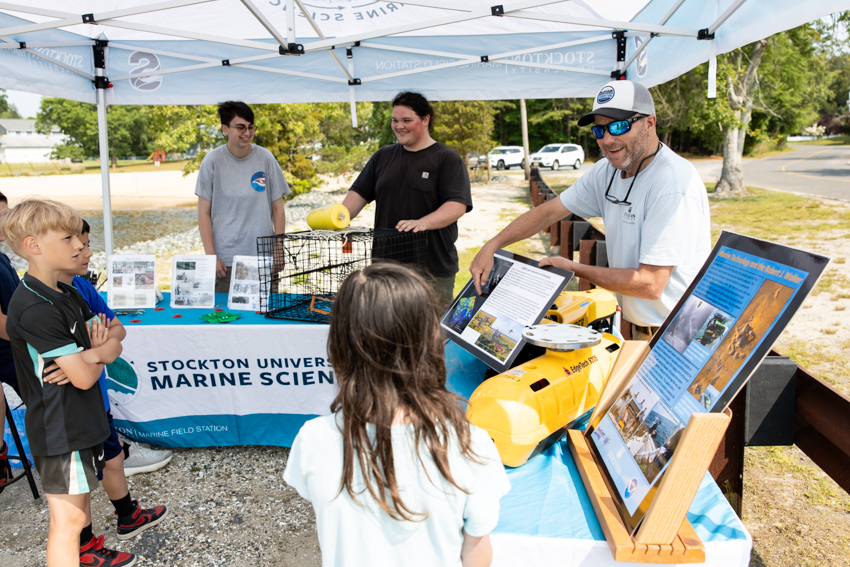Stockton Celebrates World Ocean Day with Port Republic School

Students from Port Republic School gather around a seine net to see what lives in Nacote Creek.
Port Republic, N.J. - Stockton University’s Marine Field Station celebrated World Ocean Day by sharing its research projects ranging from shipwreck discoveries to marine debris removal with students from Port Republic School.
Steve Evert, director of the Marine Field Station, pointed to Nacote Creek and asked, “What beaches do you visit? Do you think this water is connected to the ocean you swim in?”
Students called out Brigantine, Ocean City and Long Beach Island. They were split on whether the creek was connected to the ocean water.
“This is tidal water. The water you swim in at the beach is connected to Nacote Creek. At some point in time the water in the creek will eventually be out there and vice versa. As tides come in and out, the water mixes,” he said.
Evert’s goal was to show the kindergarten through eighth grade classes that the field of Marine Science is as deep and broad as our oceans during the June 6 event, ahead of the official World Ocean Day on June 8.
The workshops were centered on Nacote Creek, a tributary of the Mullica River leading out to the Atlantic Ocean by way of Great Bay.
Discovering Underwater History
Photographing a shipwreck in the Mullica River “is like trying to take a picture of a penny you dropped in a coffee cup,” said Stephen Nagiewicz, an instructor of Marine Science, who sported his Explorers Club hat.
His analogy explains why he uses sonar, a sounds system, to take underwater images. “You just can’t see because the water is so murky, but we can find the shape of the ship and things like this,” he said, pointing to a table full of artifacts.
He picked up a dark glass whiskey bottle in one hand and a globular shape of blue and black glass in the other.

Both were found on the Phoel Wreck buried in the sand, one perfectly intact and the other melted into a blob.
The Phoel is one of 10 British ships linked to the Revolutionary War resting at the bottom of the Mullica River.
“These shipwrecks are not too far away from you. When you go over the parkway in Port Republic, you are going over the Mullica River, and the British came in with 10 ships and 400 marines with the idea that they were going to kill all the settlers. They didn’t want the privateers stealing their boats, so they came in at night, killed a bunch of men in Little Egg Harbor, and then they came into the river and burned all the colonial ships,” Nagiewicz explained.
Meeting the Fish of Nacote Creek
Dave Ambrose and Nate Robinson, staff at the Field Station, hauled a seine net through the water to catch a sample of the fish that live in Nacote Creek. Students anxiously waited at the shoreline.
When the net landed, they quickly moved the frenzy of life into containers of water. Mark Sullivan, professor of Marine Science, and his students were ready to identify the species and make measurements to demonstrate how biologists process fish during sampling.
Sullivan was excited to compare this year’s catch to the previous year. Data over time informs biologists how fish populations are doing.
Sullivan pointed out the barbels on a brown bullhead catfish used to detect prey on the bottom. The catfish was a new species this year.

“They’re like garbage cans. They’ll eat anything,” a student yelled out.
“What’s that blue fish,” another student asked.
The sun hit the stripes on the banded killifish reflecting a blue iridescence.
Tatiana Anderson, a junior Marine Science major from Riverside, volunteered to help the students learn about the fish of Nacote Creek.
“I like the ocean because we know more about space than we do about the oceans right here. There’s so much we don’t know about,” she said.
When she’s not studying the ocean, she enjoys fishing and beach walks.
Angelina Oliva, a sophomore Marine Science major from Vineland and an event volunteer, said, “My favorite creature is the horseshoe crab because they have been around since the Cambrian period and haven’t evolved, which is really cool. A lot of people call them the perfect creation.”
Oliva wore a horseshoe crab telson (tail) necklace.
The Life of an Oyster
“The Mullica River is one of the only significant self-recruiting and self-maintaining oyster populations in New Jersey other than Delaware Bay and oyster farming,” Evert said.
Christine Thompson, associate professor of Marine Science, explained the lifecycle of an oyster.
In a display tank, a tiny crab hid between the oyster shells to demonstrate how reefs provide protection for other marine life.
Oysters begin their lives as larvae swimming in the water column until they get to the settling stage where they have about two days to find a hard substrate to attach to on the seafloor. If they don’t find something to settle on, they’ll get suffocated by the muddy bottom and die, Thompson explained.
Thompson developed a game for the students to learn about oyster recruitment. She handed out cardboard boxes labeled with circles on the inside bottom and 10 beads to small groups. The boxes represented the bay with the inside circles representing suitable reef habitat, and each bead represented a settling oyster.
Students added the beads to the boxes, gave them a good shake and then opened them up to see how many beads landed on the circles of reef habitat.
Thompson tallied the results from each box to calculate the percentage of oysters that survive to recruitment on a reef.
Using Marine Technology to Clean the Seafloor
“There are hundreds of these crab pots in the Mullica River Great Bay system, and unfortunately, once in a while, a boat might hit the buoy. What do you think happens when they hit the buoy,” Evert said.
“It gets tangled in the prop,” a student said.
“Call Sea Tow,” another said.
“Cut it,” another added.
Crab pots that get detached from their buoys, known as ghost pots, start littering the bay and continue to trap marine life.
With grant funding from the National Oceanic and Atmospheric Administration (NOAA), Stockton recovers the ghost pots for recycling or to return to the crabbers.
To illustrate how they find marine debris underwater, he talked about fish finders on boats.

The transducer on the back of the boat “yells in the water and then it listens. The amount of time it takes for that sound to hit the seafloor and come back tells you how deep the water is. We use sound to look for things underwater,” he said.
He also showed them one of Stockton’s remotely operated vehicles (ROV) that can capture photos and footage underwater.
Lora Panepinto, a junior Marine Science major from Staten Island, N.Y., and Wyatt Bruck, a senior Environmental Science major from Millville, worked with Evert over the past year on the marine debris removal project.
When Panepinto asked how many students played video games several hands shot up.
Bruck held up the ROV controller that looked just like an Xbox controller.
Panepinto’s connection raised the level of excitement as the students could picture themselves driving the robot through the ocean just like playing a video game.
What Does Water Quality Tell Us?
Anna Pfeiffer-Herbert, associate professor of Marine Science, and Elizabeth Bick, Field Station assistant, brought water quality instruments to measure the change in water level, temperature, salinity, dissolved oxygen and current speed.
“Taking these measurements is going to help us understand why the fish are living here. Fish have certain requirements and preferences. Some like it salty, some like it fresh. Some like it warm, some like it cold,” Bick said.
Pfeiffer-Herbert brought oranges to calculate current speed.
Students decorated and named their oranges before they were tossed off the dock for a race. After the countdown, they started their timers to track how long it took for them to drift from one piling to the next.
They cheered for their oranges as the outgoing tide pulled them out of the creek.
The Ocean Connects Us
Kayleigh Friend, who graduated in May from Stockton with her master’s in Education, said, “World Ocean Day is a global celebration, so we registered our blue space here online, so that the kids can see that we’re all connected by the ocean.”
The students left Nacote Creek with a better understanding of the creatures and history underneath the surface and with their first experiences using marine instruments to study the water.
Faculty answered plenty of questions throughout the day but showed the students that many more questions need to be asked and researched to learn more about the ocean frontier.
Reporting and photos by Susan Allen


